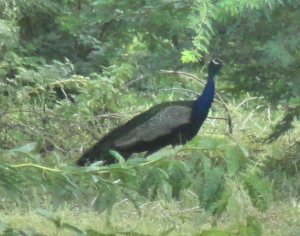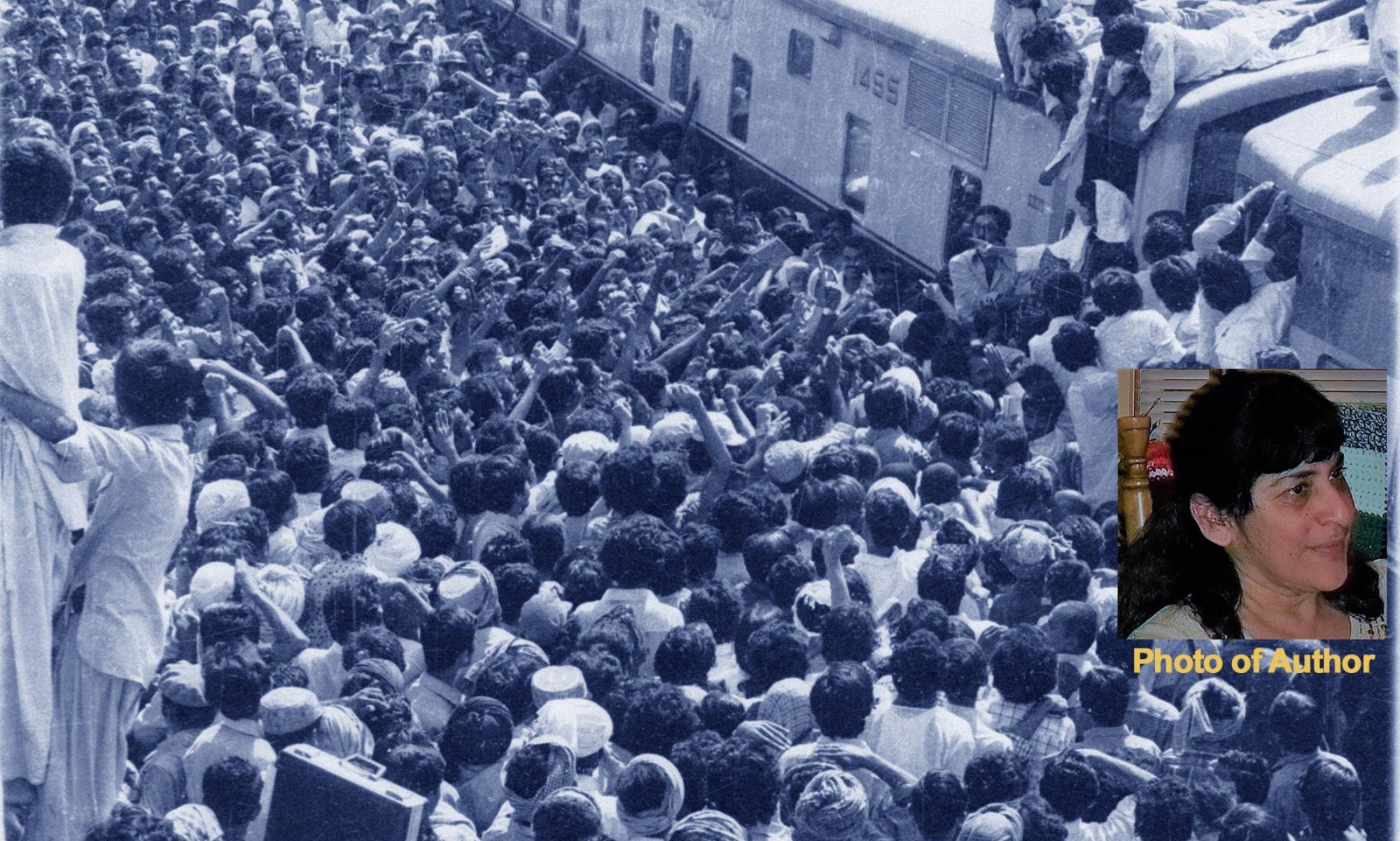
Although the Indian and Pakistan army patrols both sides of the Thar border, there is commonality between the religious groups that have stayed behind since 1947. The Tharis share grinding poverty — living as they do, in cone shaped huts, drinking shallow ground water and subsisting on wild plants and herbs. They are herders and growers in a small market economy, where there is little money to buy the goods found in the cities.
While much of Pakistan suffers from communal and sectarian killings, there is a sanctity for life in the desert. In Bhodesar, mosque and mandir (Hindu temple) coexist side by side, and are visited by people of both religions. In the mandir’s the Hindu way of life is present, with women praying indoors… while men play devotional songs in more open spaces. Water and food is shared among the creatures that live around; big dodo birds that are extinct elsewhere, mix with the common crows with impunity.
In Islamkot, there is a water fountain, where peacocks come to drink water in the early mornings and evenings, even as they sit on top of trees under the blazing sun.
It is in the poetry and songs sung by faqirs (dervishes) in undulating sands lit by the moon, that carries the message of peace between the communities. Whether it is the songs of Shah Abdul Latif Bhitai or Shaikh Ayaz, the intoxication with which the sufis render their songs, to the accompaniment of harmonium and drums, carries away listeners. The peacocks crying out from behind the veil of darkness seem to be as much part of the music troupe.
We witnessed one such performance near the desert’s border with India.. where a sturdy rows of lights were the only evidence of the division of Sindh. We had crossed the salty lowland that stretches to the Rann of Kutch… which was invaded by Indian troops in the 1965 war and only partially returned to Pakistan. It was a reminder of the territorial hostility that remains between the two neighbors. Lurching over ditches and marshes, our four wheel drive rumbled near the Indo Pak border and settled on the sands to hear musicians.
The verses I had heard earlier from our hosts came to mind,
“Hindu banay ga, na Musalman banay ga
Insaan ki aulad hai, insaan banay ga”
(You will be neither a Hindu, nor a Muslim
You are descended from a human, you will be a human)
But these ideals aside, it is the realpolitik of partition that dominates the reality for Hindus and Muslims on both sides. Over the last decade, the army transformed the Tharparkar desert from undulating sand dunes — formerly traversed by giant crab like vehicles — into a region accessible by metal roads. The roads from Mithi, Islamkot to Nangarparkar have brought security check posts and Rangers , and restrictions on cameras, laptops and other equipment.
In this border race, India has reportedly acquired more sophisticated equipment to monitor border activity. It is this technological race that is keeping Pakistan’s armed forces on its toes.
For the ordinary Tharis, life goes on as it might have centuries ago. As a local medical practitioner, Dr Khatau Mal puts it, new roads means that he now receives more victims of motor bike accidents as compared to snake bite. With endemic poverty, the doctor says the only reason more Hindus don’t migrate to India is that they are too poor to afford the journey.
Today, drinking water is still a precious commodity. Those with access to underground wells are lucky. The Tharis use donkeys, or people to turn pulleys.. tied with ropes to a bucket.. turning it clock wise and anti clockwise to draw water from the deep wells.
There is a well in Bhalva that would have been common place, but for the legend that it was the spot where Marvi filled water when Umar Soomro — the King of Umarkot — kidnapped her in the 14th century. That became the inspiration for Bhitai’s poetry of the young woman’s resistance to Umar’s wealth and power, and her success in eventually returning to her own people in Thar.
In the last three years, the heavy downpours in Sindh have changed the desert into large swathes of green. It has led to mushrooming of wild plants, which provide fodder for animals and food for people. The rains have left streams of water trickling down from the Karoonjhar hills – filling the dams and lakes below.
It is also the non governmental organizations that are starting to make a difference. Thardeep Rural Development Program is one such NGO that is putting down roots here. It has earmarked villages throughout the desert where people are being empowered to improve their access to water sources, education and the means of earning a livelihood.
The TRDP has a model rest house in Nangarparkar, which is already implementing environmentally friendly policies like using solar power, water conservation and local building materials. The impressive building – which opens up to the Karoonjhar hills – will have a convention center as well. It is a work in progress that promises to improve the quality of life for all the desert people.
Meanwhile, in a country wracked by sectarianism and intolerance , there is much to be learnt from Tharparkar. This “green desert,” that stretches to the Indian border, embodies the spiritual strength with which Sindh has learnt to deal with its adversities.

“Alas! Peacocks in That Dance No More”
By
Dr. Ahmed Makhdoom
Sindhyata, Spirituality ‘n Sufism: In this short ‘n simple Verse, murshid Saaeen Shah Bhittai, has given us the Magnificent Message of Sindhyata – when a native soul, child of the soil of Magnanimous Sindh, is anxiously, lovingly ‘n tenderly calling ‘n crying for the kindred bird, who has for a long time been staying in a foreign land with aliens ‘n unknowns!
آءُ اُڏامي ”هَنجَڙا“! سَرَ ۾ سارينئي،
متان مارينئي، پاڙِهيري پَههُ ڪري،
(سُر ڪارايل؍ شاهه ڀٽائيؒ)
“Aau uddaamee, Hanjrraa! Sara mein saaryanaee;
Mataan maariyanaee, paarrheiree paha karei!”
(Shah Bhittai)
“O kindred bird! Come flying hither, native kinsfolk in land for thee hanker;
And worry that cruel hunters thither, may scheme harming thee yonder!”
(Shah Bhittai: Translated by Ahmed Makhdoom)
Sadly, the beautiful Peacocks in my Motherland Sindh’s beautiful Thar Desert are on their way to extinction! Oh Woebegone, Arab game-hunters hunt them for sport, Sindhi Feudal Lords eat them for dinner and the occupying savage Armed Forces of Paki-Punjabistan eat them for lunch!
ويا مورَ مَرِي؍ ھَنجُ نہَ رَھيو ھيڪڙو؍
وَطُن ٿيو وَرِي؍ ڪُوڙَن ڪانيارن جو؍
(شاهه ڀٽائيؒ)
“Wiyaa mora maree, hanju na rahyo heikrro,
Watanu thhiyo waree, kuurrani kaanyarani jo.”
(Shah Bhittai)
“Peacocks in my land dance no more,
Swans in my lakes swim no more,
My beautiful motherland is ruled,
By lying tyrants, cruelly ‘tis slewed.”
(Shah Bhittai: Translated by Ahmed Makhdoom)
And, I am just a simple, naive, humble, long-suffering Son of Mother Sindh,
Ahmed Makhdoom
Many visitors used to visit THAR whenever it turned into green belt during monsoon, but Nafisa, you have pen down all the prominent features of this unfortunate land.
The stuff posted is very tremendous and so knowledgefull.
Incredible!
“In a country wracked by sectarianism and intolerance , there is much to be learnt from Tharparkar. This “green desert,” that stretches to the Indian border, embodies the spiritual strength with which Sindh has learnt to deal with its adversities”-Nafisa rightly acknowledged.
Hi i come from islamkot where peacock used to dance on my mari(ist floor) and there so many thing of unity is there that there no stick to fight so what of gun .even if gun no body will take courage to shoot . one day one manghanhar who i call when i go my willage for singing hindu bhajans and some other on next day. he told me without hindoos these manganhar will die of hungar .the interdependance. one day i called jani whose paents also work in our house ,i asked today is eid u go for id namaz .he told me that why i dont go to temple.he then told me of shah latif that roza ain namaz ee pinn changoo kamm .i live in london physically but when i wake up from sleep in islamkot where my soul is. now there are still few morrs asper yesterday”s report that they hear their calls .god bless u .jhaman ex prof at Jinah hosp karachi
Well researched article on this fabulous part of Sindh where life is as primitive as it was centuries ago and the change of social norms is very slow and rare.
Amazing area , TRDP is doing awesome development work.
Anyone wanting carpets should buy them from TRDP carpet weaving training centre
Beautiful piece! Nafisa’s writings always inspired journalists, artistes, activists and nature lovers.
Great story!
informative.. 🙂
worth reading articles that highlights all the descriptions of Thar desert
no doubt deeply analyzed & very informative.
loving work, you always inspire with your writeups…
I come from islamkot. I am helping in the mosque wall. Most of the peacocks have been eaten by the army and the rest by disease. I remember I used to catch peacocks on the first floor of my home. I being in England on my own, daily in my dreams visit my village and want to come and die there in the sandy dunes.. my last days of life, then I will feel every thing has been earned for life.